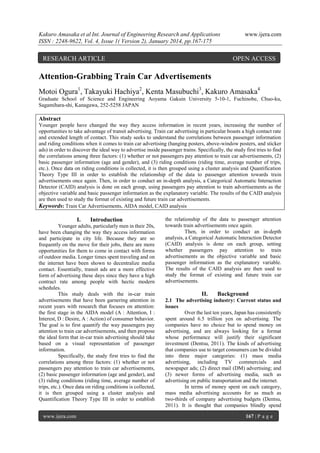This study examines the effectiveness of train car advertising by analyzing correlations between passenger attention, demographic information (age and gender), and riding conditions (duration of travel and frequency of trips). Using statistical methods such as cluster analysis and categorical automatic interaction detection (CAID), it aims to identify the ideal formats for in-train advertisements to enhance consumer engagement. The findings suggest that different advertisements yield varying attention rates based on passenger profiles and riding contexts.








![Kakuro Amasaka et al Int. Journal of Engineering Research and Applications
ISSN : 2248-9622, Vol. 4, Issue 1( Version 2), January 2014, pp.167-175
References
Amasaka, K., (2005), ―Constructing a
Customer Science Application System
CS-CIANS - Development of a global
strategic vehicle Lexus utilizing New JIT -‖,
WSEAS Transactions on Business and
Economics, Issue 3, Vol.2, pp. 135-142.
[2]
Amasaka, K., (2007), ―The validity of
Advanced TMS - A strategic development
marketing system utilizing New JIT –‖, The
International Business & Economics
Research Journal, Vol.6, No.8, pp.35-42.
[3]
Amasaka, K., (2009), ―The effectiveness of
flyer advertising employing TMS: Key to
scientific automobile sales innovation at
Toyota‖, The Academic Journal of
China-USA Business Review, Vol.8, No.3,
pp.1-12.
[4]
Amasaka, K., (2010), ―Changes in marketing
process management employing TMS:
Establishment of Toyota Sales Marketing
System‖, The Academic Journal of
China-USA Business Review, Vol.10, No.7,
pp.539-550.
[5]
Dentsu, (2011), Advertisement expenses in
Japan (2011), http://www.dentsu.co.jp/
books/ad_cost/2011/index.html.
(in Japanese)
[6]
Dentsu, (2011), Advertisement expenses of
each media in Japan (2011), http:// www.
dentsu.co.jp/books/ad_cost/2011/media.html.
(in Japanese)
[7]
Ferrell, O.C., and Hartline, M., (2005),
Marketing Strategy, Thomson SouthWestern.
[8]
Gonda, M., (2004), (Master thesis) A study of
the latent function of train media: Focusing
on the index of the local society formed by
contact with train media, Tsukuba University
(Unpublished) (in Japanese).
[9] Murayama, T., et al. (1982), Analyzing CAID,
Marketing review: Japan research center, pp.
74-86 (in Japanese).
[10] Mehta, A., (2000), ―Advertising attitudes and
advertising effectiveness‖, Journal of
Advertising Research, Issue 3, Vol.40,
pp.67-72.
[11] Shimizu, K., (2004), Theory and Strategy of
Advertisement, Soseisha. (in Japanese)
[12] Takenaka, Y., and Harada, M., (2003), ―The
study of the degree of information contact by
the traffic advertisement and spectating
professional baseball games – Focusing on
Osaka Kintetsu Buffaloes-‖, Proceedings of
Osaka University of Health and Sport
Sciences, Vol.35, pp.15-23.
[13]
[1]
www.ijera.com
[14]
www.ijera.com
The Kanto Transit Advertising Council,
(2006), A Joint Survey of Transit
Advertising (March, 2006), http://www.
train-media.net/report/0502/adreport.pdf. (in
Japanese)
The Kanto Transit Advertising Council,
(2009), A Joint Survey of Transit
Advertising (March, 2009), http://www.
train-media.net/report/0612/0612.html. (in
Japanese)
175 | P a g e](https://image.slidesharecdn.com/u4102167175-140130012327-phpapp02/85/U4102167175-9-320.jpg)